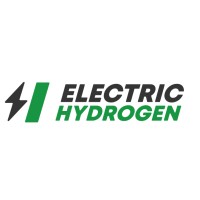Register
Electric Hydrogen manufactures, delivers and commissions advanced PEM electrolyzer units for large-scale green hydrogen production.
Published October 14, 2021
•
Updated December 16, 2024
Energy Transition
Industrial Decarbonization
H2 & Low Carbon Fuels
Hydrogen
Product Overview
Overview
100MW Plant
Electric Hydrogen's 100MW Plant is a fully integrated solution for hydrogen production, emphasizing low-cost and efficient operation, and including entire balance of plant. This pre-assembled plant features a standardized full-plant design, integrating all key components to enhance reliability and reduce costs. The plant utilizes advanced PEM technology, producing a high hydrogen output from fewer stacks, thus lowering system complexity and cost. It's designed for efficiency, with a dynamic operating range suitable for load-following renewables.
Key specifications
- Hydrogen Output: 1,900 kg/hr at peak, with a purity greater than 99.9%, primarily containing water vapor as an impurity.
- Plant Efficiency: Ranges from 45.2 to 54.3 kWh/kg, inclusive of balance of plant losses.
- Quick Standby Recovery: Less than 2 minutes to transition from standby mode to hydrogen production.
- Operational Ramp Rate: 1% per second.
Product Inputs and Parameters
- Power Input: Medium Voltage at 34.5 kV AC, 3-phase 60 Hz, with a power of 106 MVA.
- Water Consumption: 13 L/kg H₂, equating to 25 m³/hr at peak.
- Ambient Temperature Range: Operates efficiently from -20°C to 50°C.
- Plant Area: Less than 6000 m² (under 1.5 acres).
- The plant adheres to various North American standards, including ISO 22734:2019 and NFPA70.
Electrolysis Analytics Tool Electric Hydrogen is developing a suite of electrolysis analytics tools designed to aid customers and industry stakeholders in understanding the benefits and financial aspects of producing fossil-free hydrogen using their technology. These tools are categorized based on accessibility:
Open Public Access - Levelized Cost of Green Hydrogen (LCOH): This is a complimentary, simplified tool provided by Electric Hydrogen. It utilizes key parameters such as Capital Expenditure (CapEx) and input electricity characteristics (like Levelized Cost of Electricity - LCOE and capacity factor) to generate an annual cash flow table. This tool helps estimate the cost of green hydrogen production and the project's Internal Rate of Return (IRR).
Client-Only Access - Advanced Levelized Cost of Green Hydrogen (LCOH+™): This is a more detailed tool, accessible exclusively to clients. It incorporates a comprehensive set of plant and operational parameters, including the hybridization of solar and wind power supply, the over-sizing of renewables capacity, water supply cost, and support mechanisms such as grants and tax credits. Additionally, it includes aspects related to storage sizing and costing.
PROJECTS
Gigafactory
- Location: Massachusetts
- Status: Completed
- Date: April 2024
- Capacity: 1.2 GW
- Short description: A gigafactory located in Massachusetts aiming to decarbonize industries as steel, fertilizers, shipping, and aviation.
Green Wilhelmshaven Project
- Location: Northern Germany
- Status: In development - pre-FEED
- Project owner: Uniper
- Electric Hydrogen was confirmed as pre-FEED supplier on October 2024.
- Short description: The project consists of two major systems - large-scale electrolysis, which will produce green hydrogen, and an import terminal for ammonia. Both plants will be connected via pipelines to the German hydrogen backbone and to underground storage facilities in northern Germany.
Business Model
Electric Hydrogen sells their 100MW Electrolyzer systems, inclusive of all balance-of-plant equipment, with shipping, field assembly, commissioning, and warranty included.
Included in their balance-of-plant offering:
- Electrolyzer stacks
- Gas separation units
- Stack Power systems
- Thermal management
- Water treatment
Estimates of final cost for various scenarios can be modeled through their free analytics tool
Technology Innovations
Advanced PEM Technology: Electric Hydrogen uses advanced Proton Exchange Membrane (PEM) technology in their electrolyzers. This technology is known for its efficiency in hydrogen production, and Electric Hydrogen's IP allows for higher hydrogen output from fewer stacks, reducing both system complexity and cost.
High-Capacity Production: Their 100MW solution indicates a focus on large-scale hydrogen production, which is essential for addressing the needs of large industrial users and clean energy developers.
Dynamic Operating Range: The ability of their systems to efficiently operate across a dynamic range makes them suitable for integrating with renewable energy sources, like solar and wind, which have variable output.
Economic Efficiency: Electric Hydrogen emphasizes the reduction of both project and operating costs. Their tools, like the Levelized Cost of Green Hydrogen (LCOH) and the advanced LCOH+™, demonstrate a commitment to transparency and making green hydrogen economically viable, addressing a major barrier in the hydrogen production industry.
Custom Analytics Tools: Electric Hydrogen provides specialized analytics tools to help customers understand the economics of green hydrogen production. These tools, especially the advanced LCOH+™ for clients, offer comprehensive analysis incorporating various operational parameters, which is not commonly provided by other hydrogen technology companies.
Full BoP: One of the biggest hurdles with large scale hydrogen projects is system integration. By providing full BoP and commissioning services, customers will not have to source other vendors and suppliers themselves, which could lead to a much shorter deployment timeline.
Applications
Electric Hydrogen caters their 100MW solution to large industrial hydrogen users and developers of large-scale clean energy and fuels.
Ammonia Production: Essential for fertilizers, ammonia sustains life and is emerging as an energy vector to export power and as an alternative to fossil fuels.
Methanol Production: Methanol is key for manufacturing value-added chemicals and plastics and is being considered as a replacement for fossil fuels in transport applications, particularly in maritime shipping.
Iron Reduction: Iron, a precursor to steel, presents a significant opportunity for decarbonization. Using green hydrogen for iron reduction can lead to the production of green steel.
Mining Industry: In mining, hydrogen can decarbonize power, heating, and process gas applications.
Power Sector: A major focus of the energy transition, green hydrogen can be used in the power sector through dedicated pipelines, blending with natural gas, or in gas turbines and fuel cells.
